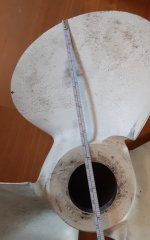Omineca
Seaman
- Joined
- Aug 22, 2021
- Messages
- 60
I have a prop that I believe to be 14x15, but although the diameter checks out, I have no idea of the pitch. Online gives me a bunch of complicated ways of calculating this, and one or two that simply don't work, so I'll have a go at figuring it out on simple first principles. My calculating will be in centimetres, but you can do it in inches if you enjoy using measurements that were already recognized as unnecessarily complex in 1795 when the metric system was introduced during the French Revolution. The result will be an approximation, but ALL methods of calculating pitch by hand are approximate.
Lay the prop, leg side down, on a smooth flat table.
Measure the radius of the propeller: it is 17.8cm for my example 14" diameter prop (I just calculated this by multiplying 7 inches by 2.54 to give centimetres). Now calculate 75% of this, which gives 13.35cm. This 75% value is the commonly accepted figure for the average amount of thrust of the prop. The diameter at this approximately widest point is obviously twice that, and we'll call it DW. In our example DW is 26.7cm.

Make small marks on the leading and trailing edges of one blade, at the 75% radius point. Measure the distance between these points on your table, as if a bright light were directly above the prop and you were measuring its shadow on the table surface. In our example we have 16.8cm for this value. We'll call it W for width.

Now measure height above the table for our marked points, in our example 10.5cm and 2.8cm. Subtract the lower value from the higher, here giving 7.7cm. We'll call this H for height.

If we now take our diameter at the 75% thrust point DW, which we recall is 26.7cm, and calculate the circumference of its circle, we'll get 26.7cm x π which gets us 83.88cm. Since your blade is 16.8cm wide it will travel 83.88cm divided by 16.8cm in each complete rotation of the propeller, which gives us 4.99 widths per rotation.
In pitch calculation we assume zero slippage, so in this theoretical perfect situation, the propeller blade will also move forward 4.99 times the height H that we measured. So we take 4.99 x 7.7cm which is 38.42cm to give us the forward progression of the prop blade with each rotation. If we wish to convert this to inches we divide it by 2.54, giving us 15.1 inches. This is close to 15 inches, and appears to confirm that my propeller is indeed a 14x15. All our measurements are subjective, so you might get 14.9 or maybe you also would get 15.1 inches for the pitch value. But this is quick, easy, and it is as accurate as the methods using protractors, dividers, plumb bobs, deely bobbers, and other wotknots that I see online.
The formula put in its simplest form is:
(DW x π x H)/W = pitch
Enjoy!
Lay the prop, leg side down, on a smooth flat table.
Measure the radius of the propeller: it is 17.8cm for my example 14" diameter prop (I just calculated this by multiplying 7 inches by 2.54 to give centimetres). Now calculate 75% of this, which gives 13.35cm. This 75% value is the commonly accepted figure for the average amount of thrust of the prop. The diameter at this approximately widest point is obviously twice that, and we'll call it DW. In our example DW is 26.7cm.

Make small marks on the leading and trailing edges of one blade, at the 75% radius point. Measure the distance between these points on your table, as if a bright light were directly above the prop and you were measuring its shadow on the table surface. In our example we have 16.8cm for this value. We'll call it W for width.

Now measure height above the table for our marked points, in our example 10.5cm and 2.8cm. Subtract the lower value from the higher, here giving 7.7cm. We'll call this H for height.

If we now take our diameter at the 75% thrust point DW, which we recall is 26.7cm, and calculate the circumference of its circle, we'll get 26.7cm x π which gets us 83.88cm. Since your blade is 16.8cm wide it will travel 83.88cm divided by 16.8cm in each complete rotation of the propeller, which gives us 4.99 widths per rotation.
In pitch calculation we assume zero slippage, so in this theoretical perfect situation, the propeller blade will also move forward 4.99 times the height H that we measured. So we take 4.99 x 7.7cm which is 38.42cm to give us the forward progression of the prop blade with each rotation. If we wish to convert this to inches we divide it by 2.54, giving us 15.1 inches. This is close to 15 inches, and appears to confirm that my propeller is indeed a 14x15. All our measurements are subjective, so you might get 14.9 or maybe you also would get 15.1 inches for the pitch value. But this is quick, easy, and it is as accurate as the methods using protractors, dividers, plumb bobs, deely bobbers, and other wotknots that I see online.
The formula put in its simplest form is:
(DW x π x H)/W = pitch
Enjoy!





















